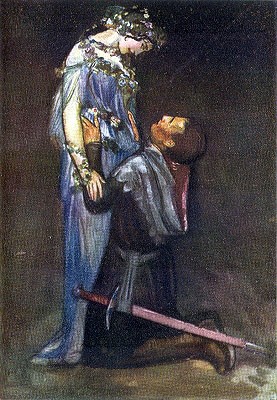 |
| "La Belle Dame Sans Merci" by Frank Bernard Dicksee. |
One of the most famous poems by John Keats is "La Belle Dame Sans Merci" (meaning "the beautiful woman without mercy" in old French). It is not exactly a short poem, but twelve stanzas is not exactly that long, either. There is an alternate manuscript version, but I chose the 1819 published version to dissect. I chose it because of the supernatural elements suggested in the poem, alluding to a 'farey', her powers, and her merciless disposal of men. A few relevant stanzas are:
Oh what can ail thee, knight-at-arms,
Alone and palely loitering?
The sedge has withered from the lake,
Alone and palely loitering?
The sedge has withered from the lake,
And no birds sing.
I met a lady in the meads,
Full beautiful - a faery's child,
Her hair was long, her foot was light,
Full beautiful - a faery's child,
Her hair was long, her foot was light,
And her eyes were wild.
I set her on my pacing steed,
And nothing else saw all day long,
For sidelong would she bend, and sing
And nothing else saw all day long,
For sidelong would she bend, and sing
A faery's song.
-(English, 2011).
To begin with, a paragraph of a summary of the poem reads:
 |
| "La Belle Dame Sans Merci" by Robert Anning Bell |
“La Belle Dame sans Merci,” written in 1819 and published the next year in a form slightly different from the one here, depicts a knight-at-arms who has been seduced and abandoned by a capricious fairy. Told in the form of a dialogue, the poem recounts the experience of loving dangerously and fully, of remaining loyal to that love despite warnings to the contrary, and of suffering the living death of one who has glimpsed immortality," (enotes, 2011).
This poem could be interpreted in a myriad of ways. There are some people who think that the fairy exists only in the imagination and others who believe her to be equitable to a siren, luring men into become her emotional slaves. One analysis takes a different route:
"The references to "faery" and "elfin" suggest enchantment or imagination. Her "sweet moan" and "song" represent art inspired by imagination. The lady, symbolizing imagination, takes him to an ideal world. The knight becomes enraptured by or totally absorbed in the pleasures of the imagination--the delicious foods, her song, her beauty, her love or favor ("and nothing else saw all day long"). But the imagination or visionary experience is fleeting; the human being cannot live in this realm, a fact which the dreamer chooses to ignore. The knight's refusal to let go of the joys of the imagination destroys his life in the real world," (Melani, 2010).
In poetry analysis, it may be hard to differ opinion from objective analysis. While searching articles and websites online, I was struck by how similar they all sound. After reading a number of them, I was able to tell them apart more easily. Here is one example of an opinion about Keats' poem:
 |
| "La Belle Dame Sans Merci" by Arthur Hugues. |
“La Belle Dame sans Merci” is one of Keats’s most beloved poems and one of the few important works that seems to evade the kind of critical argumentation invoked by the odes and long poems. Typical of critics’ magnanimity toward the ballad is T. Hall Caine’s 1882 assessment of the poem as the “loveliest [Keats] gave us.” He writes that the ballad is “wholly simple and direct, and informed throughout by a reposeful strength. In all the qualities that rule and shape poetry into unity of form, this little work strides, perhaps, leagues in advance of ‘Endymion,’” (enotes, 2011).
One can tell that it is an opinion because of the use of words like "beloved" and "important". The author believes the poem to be a beloved and important work, and that is all based on the author's own opinions. This opinion offers little in the way of new information or analysis.
English. (2011). La belle dame sans merci. Retrieved on July 25, 2011 from http://englishhistory.net/keats/poetry/labelledamesansmerci.html
Enotes. (2011). La belle dame sans merci: summary. Retrieved on July 25, 2011 from http://www.enotes.com/la-belle-dame-sans-meri/summary
Melani, L. (2010, September 27). The significance of 'la belle dame sans merci'. Retrieved on July 25, 2011 from http://academic.brooklyn.cuny.edu/english/melani/cs6/belle.html#sig

Thank you so much! I hope the post was helpful!
ReplyDelete